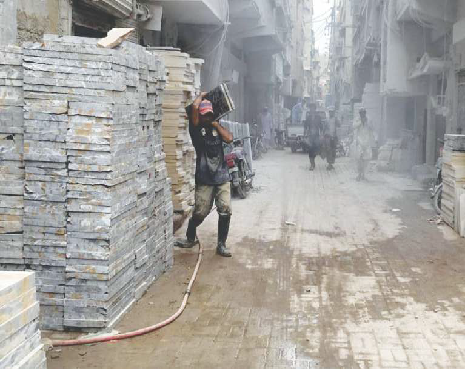Marble Processing is Polluting Karachi Neighbourhoods
 News Date: 01.10.2018
News Date: 01.10.2018
A powdery white dust covers everything in a working class locality on Karachi’s Manghopir Road. It clings to window panes, mixes with food being prepared and sold on the street and coats fixtures and furniture inside homes and other buildings. The noise is also deafening in this part of the city. Electric saws screech, cutters and grinders whirr and sanding machines hiss as fine particles of marble stone being processed at hundreds of workshops here fly and deposit themselves everywhere.
The management of several educational institutions in the neighbourhood have requested workshop owners to cease their operations during school hours. But long breaks will make these small businesses unviable.
Marble – a strong but fancy stone used in construction and decorative pieces – is cut, ground, finished and polished into various objects and artefacts at hundreds of small workshops scattered in many low income neighbourhoods between Old Golimar area on the southern edge of a sewerage disposal plant, known as Gutter Bag Hicha and Pak colony neighbourhood, a few kilometres to the north on Manghopir Road.
The workshops, usually situated on the ground floor of residential buildings in narrow, densely populated streets, hum incessantly and kick up a continual dust storm. If and when their owners and local residents sweep away the dust, they end up dumping it in nearby empty lots, along local roads and, worse still, in the bed of the drying Lyari river that passes nearby. The wind eventually brings most of it back to their neighbourhoods.
Those who work at these workshops are even more vulnerable to diseases. They usually suffer from shortness of breath. Doctors often advise local residents to leave the area for the sake of their own health but that is not as easy as it sounds.
Some local residents have tried to get the workshops closed down because they operate in clear and flagrant violation of environmental laws and urban zoning regulations.
A few families that specialised in sculpture and stone carving migrated to Karachi in 1947 from the Indian state of Rajasthan. They settled down in Pak Colony and Modern Colony when these neighbourhoods first emerged in the 1950s. Some years later, they set up a handful of marble processing workshops which soon ballooned into many hundreds as people from other communities also joined the trade.
Today, there are 380 workshops and showrooms on main Manghopir Raod and another 190 tucked inside various neighbourhoods.
There are also around 350 large marble factories along the northwestern part of Manghopir Road that cut huge marble boulders into slabs. Their raw material is usually brought into Karachi from various parts of Balochistan. These factories use heavy sawing machines, including vertical saws, bridge saws and gang saws. Each of these saws has the capacity to process up to 25 tonnes of marble in 24 hours. Each factory employs around 25 labourers.
The industrial scale saws at these factories use water sprinklers while cutting marble blocks. Each factory has a large overground tank that can contain as much as 30,000 gallons of water which is used multiple times until it assumes the form of a thick sludge that can no longer be pumped from the tank on to the saws.
The problem arises when the sludge is disposed off. It is often found dumped on empty lots and next to rain water drains all along Manghopir Road. As it becomes dry, it starts disintegrating and soon assumes a powdery form that, in turn, is blown into the atmosphere by wind.